Please use this identifier to cite or link to this item:
https://accedacris.ulpgc.es/jspui/handle/10553/77688
| DC Field | Value | Language |
|---|---|---|
| dc.contributor.author | Boulmezaoud, Tahar Zamene | en_US |
| dc.contributor.author | Alvarez, Luis | en_US |
| dc.contributor.author | Colom, Miguel | en_US |
| dc.contributor.author | Morel, Jean Michel | en_US |
| dc.date.accessioned | 2021-02-11T09:05:59Z | - |
| dc.date.available | 2021-02-11T09:05:59Z | - |
| dc.date.issued | 2020 | en_US |
| dc.identifier.issn | 2105-1232 | en_US |
| dc.identifier.other | Scopus | - |
| dc.identifier.uri | https://accedacris.ulpgc.es/handle/10553/77688 | - |
| dc.description.abstract | We describe a transparent method calculating an “effective reproduction number (ERN)" from the daily count (incidence) of newly detected cases in each country, in the EU and in each US state. We aim at getting a result as faithful as possible to the observed data, which are very noisy. The noise, being specific of administrations, shows a seven days period. Hence the incidence curve is first filtered by a seven days mean or median filter. Then the ERN is computed by a classic reproduction formula due to Nishiura. To do so requires knowledge of the serial interval function π(s) which models the time between the onset of symptoms in a primary case and the onset of symptoms in secondary cases, or equivalently the probability that a person confirmed infected today was actually infected s days earlier by another confirmed infected person. We fluse and compare several recently proposed evaluations of π, and verify that their variation has moderate practical incidence on the evaluation of the ERN. The method we present derives from Nishiura’s formula but we prove that for the adequate choice of parameters it is identical to one of the methods proposed by the classic EpiEstim (Estimate Time Varying Reproduction Numbers from Epidemic Curves) software. We find that the same method can be applied to compute an effective reproduction number from the daily death count, which yields therefore another prediction of the expansion of the pandemic. Although this application has no clear theoretical justification, we find good experimental fit of the ERN curves obtained from the incidence and from the death curve, up to a time shift. In most countries, both curves appear to be similar, with a time delay that depends on each country’s detection and administrative processing delays. Both ERNs can be consulted daily online in the demo tag associated with this paper. We refer the readers to the online demo1 to experiment by themselves. In the case of France, an ERN based on hospitalizations, new entries in ICU’s and deaths at hospitals is also computed daily2. The code is quite simple. To simplify its presentation we use a single file where all basic procedures are included, from the management of data to the parameter optimization. The reviewed source code and documentation for this algorithm are available from the web page of this article3. Compilation and usage instructions are included in the README.txt file of the archive. | en_US |
| dc.language | eng | en_US |
| dc.relation.ispartof | Image Processing On Line | en_US |
| dc.source | Image Processing On Line [EISSN 2105-1232], v. 10, p. 191-210, (Enero 2020) | en_US |
| dc.subject | 120602 Ecuaciones diferenciales | en_US |
| dc.subject | 120326 Simulación | en_US |
| dc.subject | 3202 Epidemologia | en_US |
| dc.subject.other | Daily Reproduction Number | en_US |
| dc.subject.other | Epidemic | en_US |
| dc.subject.other | Ern | en_US |
| dc.subject.other | Sars-Cov-2 | en_US |
| dc.title | A daily measure of the SARS-CoV-2 effective reproduction number for all countries | en_US |
| dc.type | info:eu-repo/semantics/Article | en_US |
| dc.type | Article | en_US |
| dc.identifier.doi | 10.5201/ipol.2020.304 | en_US |
| dc.identifier.scopus | 85099825901 | - |
| dc.contributor.authorscopusid | 6603787050 | - |
| dc.contributor.authorscopusid | 55640159000 | - |
| dc.contributor.authorscopusid | 55549886000 | - |
| dc.contributor.authorscopusid | 57203072257 | - |
| dc.identifier.eissn | 2105-1232 | - |
| dc.description.lastpage | 210 | en_US |
| dc.description.firstpage | 191 | en_US |
| dc.relation.volume | 10 | en_US |
| dc.investigacion | Ciencias | en_US |
| dc.type2 | Artículo | en_US |
| dc.utils.revision | Sí | en_US |
| dc.date.coverdate | Enero 2020 | en_US |
| dc.identifier.ulpgc | Sí | en_US |
| dc.contributor.buulpgc | BU-INF | en_US |
| dc.description.sjr | 0,359 | |
| dc.description.sjrq | Q3 | |
| dc.description.esci | ESCI | |
| item.fulltext | Con texto completo | - |
| item.grantfulltext | open | - |
| crisitem.author.dept | GIR Modelos Matemáticos | - |
| crisitem.author.dept | Departamento de Informática y Sistemas | - |
| crisitem.author.orcid | 0000-0002-6953-9587 | - |
| crisitem.author.parentorg | Departamento de Informática y Sistemas | - |
| crisitem.author.fullName | Álvarez León, Luis Miguel | - |
| Appears in Collections: | Artículos | |
SCOPUSTM
Citations
2
checked on Jun 8, 2025
WEB OF SCIENCETM
Citations
2
checked on Jun 8, 2025
Page view(s)
114
checked on May 25, 2024
Download(s)
86
checked on May 25, 2024
Google ScholarTM
Check
Altmetric
Share
Export metadata
Items in accedaCRIS are protected by copyright, with all rights reserved, unless otherwise indicated.
